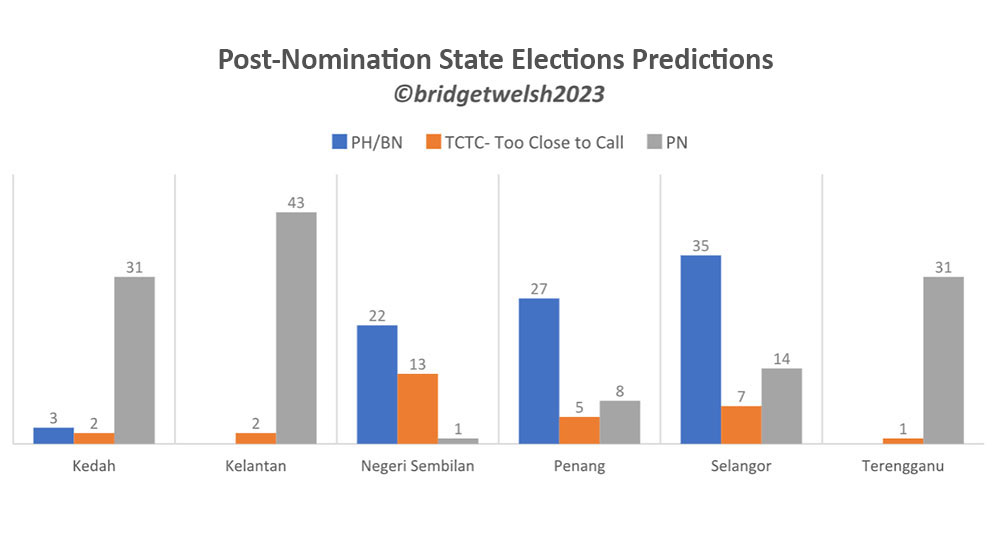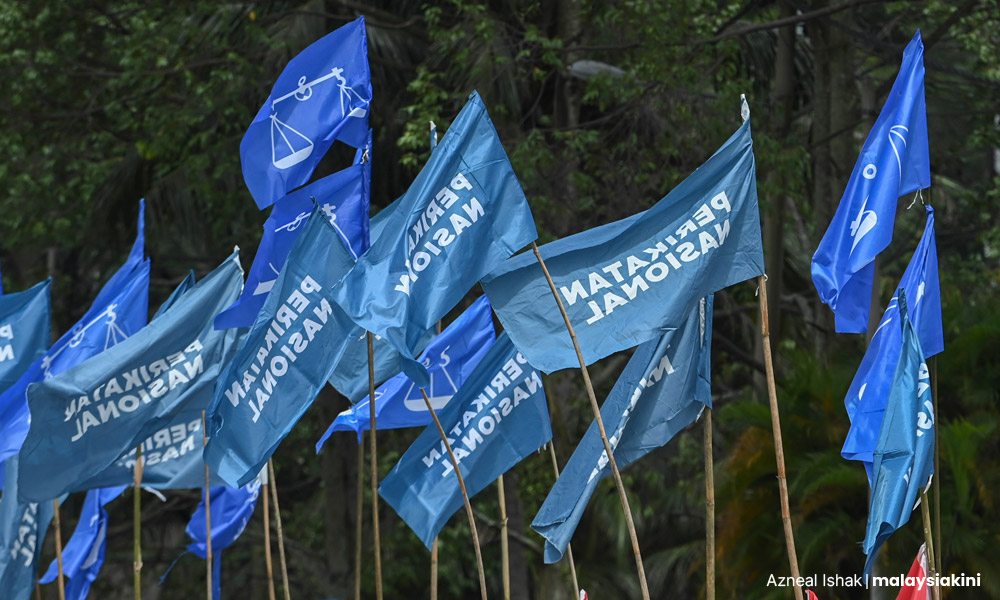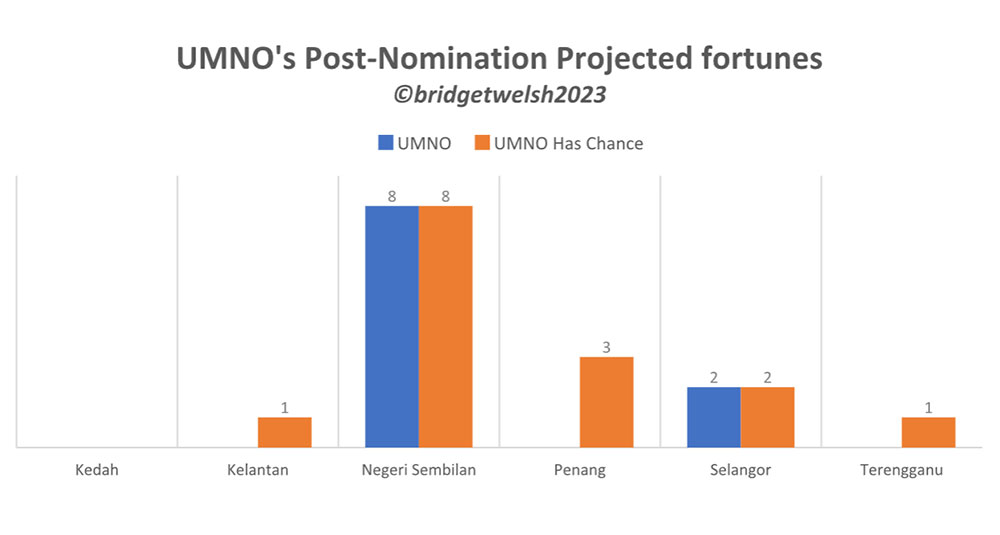The 2023 state election campaign draws to a close today. It has been fiercely fought; it has included discussion of policies and programmes alongside narratives that appeal to emotions, including last-minute appeals along racialised lines.
A total of 9.8 million voters across six states will have the opportunity to cast their ballots tomorrow. The contests remain highly competitive, especially in Pakatan Harapan- governed states, making each vote important. Turnout will be crucial in shaping the overall outcome.
At issue in the campaign is not just who will govern at the state level, but the results will impact political stability, investment into the country and inclusion of different communities.
The power of the opposition, Perikatan Nasional, is changing, as this coalition is projected to make gains across all six states.
Anwar Ibrahim’s government simultaneously should hold onto the states where its coalition parties/partners hold power, although it is likely to do so with smaller majorities.
This piece on the state polls provides an assessment of what might occur. It draws from fieldwork, available surveys and statistical simulations of possible voting patterns along ethnic and age lines.

As with any prediction piece, one needs to acknowledge shortcomings. Given the intensity of the role of emotions in this campaign, even one day can impact the outcome of the polls.
Also, the predictions are only as good as the assumptions that go into the analysis. The foundation of the analysis rests initially on patterns in GE15, as voting traditionally has not shifted significantly in a short period of time of less than a year, but also incorporates interpretation from the field about changing sentiments and views of candidates, particularly from competitive or “hot seat” areas.
Not quite status quo
Here are the findings:
No expected government change of coalition in power - None of the different coalitions should lose the state government they held before polls were called. Yet, the configuration of different parties and overall majorities of different states should change.
This may impact the party/coalition representation and role of different individuals leading different states.
Stronger PAS governments - PAS governments should gain greater support, with the opposition coalitions of BN and Harapan as viable opposition forces in these states significantly reduced. There is a possibility of no substantive elected representation of the opposition in the PAS-governed states of Kelantan and Terengganu.
Harapan-BN retains with losses - Harapan-led governments in cooperation with BN in Penang, Selangor and Negeri Sembilan should retain power but the opposition PN should gain seats.
In these three states, the two-thirds majority of unity governments previously held will be challenged by potential PN gains. The PN stands the best chance of removing the two-thirds control of the unity government in Selangor.
More divided assemblies - The gains by PN in the state assemblies along Malaysia’s west coast will make for more contentious state assemblies, with the opposition a stronger political force at state levels.
Continued ethnic polarisation - All indications that voting will continue to be highly ethnically polarised but what may distinguish this election is a potential narrowing of the representation of ethnic minorities and women in state assemblies.
A divided result
Here are the overall projected potential numbers across the different states.
In the northern Malay heartland, PAS should overwhelmingly win. In both Kelantan and Terengganu, the TCTC (too close to call) - the (very) few of such seats - also favour PAS.
One issue that has emerged late in the campaign is disgruntlement among different factions in PAS over leadership in Kelantan, but this is not yet seen to impact the outcome of contests in seats. In Kelantan, Terengganu and Kedah, PAS should win decisively.

In Selangor, despite increased competition, Harapan working with BN should retain this government, largely from long-standing support for the state government.
PN should, however, make significant gains in their representation, but at this juncture, these gains appear inadequate to change the government.
Many of the seats that Harapan should win, especially most of those by the DAP, should be won comfortably.

It is in seats where there are a higher number of Malay and younger voters that PN should win, notably in northern Selangor. At least seven seats remain too close to call at this juncture, including Hulu Kelang and Gombak Setia.
In Penang, PN should make similar gains, although in lower numbers, with the government being retained by Harapan.
PN’s projected gains are concentrated on the northern mainland of Penang. Five seats remain too close to call, such as Bertam and Telok Ayer Tawar.
In Negeri Sembilan, the unity government coalition partners should retain the most seats, but PN is similarly making inroads.
There is only one seat that PN is projected to win at this juncture, Bagan Pinang, but there are 13 seats that are too close to call, including the seat where caretaker Menteri Besar Aminuddin Harun is contesting in Sikamat.
Changing party fortunes
Of all the parties contesting, the DAP is projected to win most of the seats it is contesting. There are some seats that remain challenging for DAP, however, including Sungai Pelek in Selangor.
All the unity government parties contesting in Malay areas and where there are large numbers of younger voters are facing greater challenges from PN and should experience losses across the six states.
Despite being likely to lose many seats, Umno should not be wiped out politically, as it is projected to hold onto seats in Negeri Sembilan and has some chances to win seats elsewhere, notably in Penang and Selangor.

PKR and Amanah are facing intense close battles in many of their seats, including those in Negeri Sembilan such as Ampangan for PKR, Paroi for Amanah and Batu Tiga for Amanah in Selangor. PKR is facing serious challenges to its previously held seats in southern Kedah, such as Bukit Selambau.
Muda is not projected to win any seats and will perform unevenly across the seats it is contesting.
In the overwhelming number of seats where Muda is running, it is not “splitting the vote” as being touted.
In less than a handful of seats where Muda is contesting, the party is serving as a vehicle to register protests against incumbents and capitalising on outreach to youth. It has showcased the importance of youth in this election, but also has revealed the difficulties a youth party faces to make gains electorally.
Polling is only hours away. What will impact the outcome is how parties are able to mobilise their supporters in these final hours and how many voters come out.
An overall turnout of below 70 percent will advantage PN, as their campaign in these six state elections has most mobilised their base.
These projections, however, indicate that politics in Malaysia is transforming and these elections will be decisive in setting the direction for not only the six states but the country’s future. - Mkini
BRIDGET WELSH is an honourary research associate of the University of Nottingham, Malaysia’s Asia Research Institute. She is also a senior research associate at the Hu Fu Centre for East Asia Democratic Studies and a senior associate fellow at The Habibie Centre. Her writings can be found at bridgetwelsh.com.
The views expressed here are those of the author/contributor and do not necessarily represent the views of MMKtT.



No comments:
Post a Comment
Note: Only a member of this blog may post a comment.